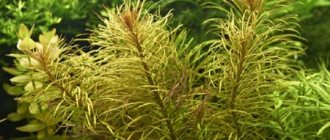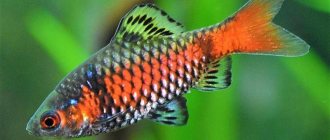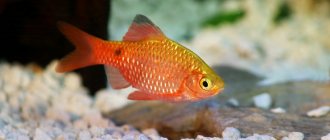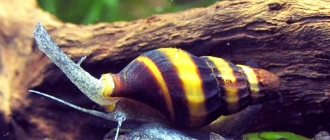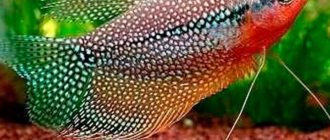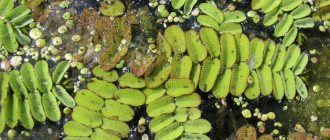Description
The hornwort plant is a rhizomeless species. It lives in the water column and rises to the surface. Sometimes it clings to supports with stem shoots-rhizoids and absorbs substances necessary for development from the silt. The dissected leaves are divided into thread-like plates resembling a spruce branch. Looks attractive in any size aquarium.
If you look through a microscope, you can see small teeth. Nutrition is produced by all cells on the surface of the plant, covered with a fat-like film. Color ranges from light green to brown. Survives at temperatures of 6…30°C.
It blooms with petalless corollas up to 0.2 cm long, which when ripe resemble nuts. It contains tannin, a bitter-tasting substance, so aquatic algae lovers do not touch it.
Habitat in nature
Hornwort grows in almost all bodies of water on the planet : from the northern regions to the hot and humid tropics. Prefers fresh water with low transparency. In its natural habitat it grows at a great depth of up to 10 meters, as it hides from sunlight, which can destroy the plant. This species densely covers the bottom of the reservoir, making it difficult for other species to grow. Dense hornwort thickets are home to bottom-dwelling fish and small species, hiding between the fluffy leaves from predatory species.
Kinds
There are several dozen species of hornwort found in nature, the descriptions of which differ in the structure and color of the leaf apparatus.
The following types are common in home aquariums:
- Hornwort submerged. A characteristic difference is dark green foliage. The stem is long, branching. Feels good in slightly alkaline, moderately hard water. Under natural conditions, the perennial lives in water up to 9 m deep. It has a high degree of vitality and is capable of cleaning water well from dirt.
- Hornwort semi-submerged. The color of the “needles” ranges from light green to red. Delicate and fragile, grows on a long stem. It looks impressive in an aquarium, planted along the back wall. Under normal conditions it can grow up to 20 cm in a week.
- Cuban hornwort is very decorative due to the fluffy dark green leaves and bright red stem. It is distinguished by an unusual color combination and a shape that resembles a bunch of grapes. Prefers good lighting, which helps it create short internodes and a dense leaf cluster. Having reached half a meter, it begins to branch. With a lack of lighting, the growth rate decreases. Valued for its strong shoots that are not prone to breaking off.
- Mexican hornwort is one of the most unpretentious. Looks like the classic dark green (submersible) hornwort. The stem is dark brown, and the side shoots grow in pairs. Each plate is bifurcated. It floats freely on the surface and can settle on the bottom.
Attention! The least commonly found on sale is the semi-submersible one with light green leaves due to its fragility and difficulty in transportation.
Hornwort varieties
If we consider the family of this aquarium plant, it is worth noting that it includes only a single genus, in which taxonomists distinguish 6-30 species of hornwort. At home you can find only 4 of the most popular species. Plants differ from each other in color, shape, density.
Immersed
Hornwort submerged has another name, namely, dark green. This is the color the leaves and stem are painted in. The leaves are narrow, needle-shaped, and resemble horns in appearance, which became the basis for this name. Under favorable conditions, the length of the plant reaches about 2 m. It can grow in water, the temperature of which varies from +18 to +30 degrees.
Mexican
The Mexican variety of hornwort has red-brown stems and belongs to the submerged subspecies of aquarium plants. Red-stemmed hornwort is considered perhaps the most unpretentious variety of aquarium plants belonging to the Hornwort family. A distinctive feature is that this variety feels great both at a temperature of +30 and at a temperature of +5.
Semi-submerged
Hornwort semi-submersible is excellent for growing in small aquariums. Which is due to fairly slow growth. The plant has a light green tint.
Cuban
If we consider the Cuban hornwort, it is worth noting first of all that the whorls are quite close to each other, as a result, in appearance the aquarium plant resembles a spruce branch or the long and rather fluffy tail of a wild animal. This variety is considered the most attractive. For cultivation, it is necessary to create favorable conditions, in particular bright lighting.
Benefits for the aquarium
Hornwort in an aquarium is not only a successful ornamental plant, it performs the function of a continuously working biological filter. Collects and processes waste products of aquatic inhabitants and dead organic matter. This is his main merit.
The plant is recommended to be grown for the following reasons:
- Excellently “pulls out” nitrates, which are the end product of the nitrogen cycle.
- Thanks to its ability to release oxygen, the fish feel better and the fry develop quickly.
- Caviar sticks well to the needle-shaped algae leaves, which contributes to successful throwing.
- Tiny aquarium inhabitants feel safe in dense branches.
This useful aquatic plant significantly improves the condition of the aquarium and accelerates the adjustment of biological balance.
What is the plant useful for?
Photo: Hornwort in reservoirs
The benefits of hornwort as an aquarium species are as follows.
- The plant absorbs harmful chemicals released by fish feces and tap water, such as nitrates, ammonia, phosphates and carbon dioxide.
- Enriches water with oxygen.
- Due to its ability to purify water, it acts as an additional filter for mechanical filtration of water in an aquarium.
- The dense leaves of Ceratophýllum serve as a storage place for fish eggs.
- Small fish and juvenile adults use the thick leaves of the plant as shelter.
- Keeping hornwort adds extra texture and interest to your aquarium.
- Ceratophýllum protects shrimp from attack by other large fish in a community aquarium.
Keeping in an aquarium
Hornwort does not have a root; absorption of nutrients occurs over the entire surface. Therefore, it does not matter to him what type of soil. The plant is unpretentious, but you should not test its strength, but give it the opportunity to fully perform its cleansing function. It is important to provide the plant with 10 hours of daylight without direct sunlight and warm water.
How to care
Conditions in which aquarium hornwort feels best:
- It is advisable to place large driftwood or stones on the bottom and secure the plant.
- It will not die at 5°C, but active development and bright color can be expected at a temperature of 20…24°C.
- The size of the aquarium must correspond to the degree of growth, since the plant can quickly fill the space. Recommended volume: 100 liters.
- Aggressive sun rays are harmful to most aquatic inhabitants, including hornwort.
- Under artificial lighting, the power of a fluorescent lamp should be 0.4 W/l.
- Aeration and filtration can be used at medium or low power, and the flow can be directed in the other direction.
The level of nitrates affects the condition of the green hornwort, but additional fertilizer is not necessary. Once a week, a fifth of the water volume should be renewed. This helps maintain the pH at 5.5.
This is interesting! Snails love to eat algae, but they won’t touch hornwort because of its bitter taste.
Reproduction
Breeding is easy. To get a new “seedling”, you need to break off a young shoot and let it float freely. Sometimes the stems separate on their own. Hornwort can be propagated through cuttings. It is required to divide the main stem into parts. Each segment will develop independently if the water is provided at room temperature. During the process of vigorous growth of shoots in favorable conditions, the owner of the aquarium needs to ensure that they do not fill the entire container.
How to fix hornwort in an aquarium
Plants that are fixed to the bottom look more aesthetically pleasing. Therefore, aquarists try to create the hornwort in the form of a bush growing from the ground, although the plant itself does not need this. You can “plant” hornwort as follows:
- wrap the stem around a transparent rod and secure it at the bottom with a tourniquet;
- use stones with holes as “anchors”;
- secure with fishing line to the snags.
You can plant hornwort in an aquarium in any way, but it is important to know that it will grow in a short time. It is necessary to work as a gardener and adjust the composition. The lower stem of the plant is sometimes cut off, as it turns yellow and becomes bare.
Why does it turn yellow and not grow?
There are situations when the hornwort in the store has grown over the entire aquarium, and when moving to a new place of residence it turns yellow or drops its leaves.
The reasons may be as follows:
- large differences in the indicators of the aquatic environment in the new and old aquariums (temperature, acidity, hardness);
- direct exposure to sunlight;
- unsuccessful transportation (long journey with lack of moisture, hypothermia);
- Nitrate levels are too low.
Before adding hornwort to an aquarium, you need to think about the conditions of its maintenance and carefully transport it in a container with water, protecting it from low temperatures.
What to do if the hornwort is sick
The plant practically does not get sick. When a fungal infection develops in an aquarium that threatens the well-being of its inhabitants, it is removed and washed under running water. Then they are treated with a solution of manganese and deposited in a separate container. Keep there until the aquarium is free of harmful microorganisms. Stems yellowed by the sun are cut off.
Diseases, their treatment and prevention
Hornwort is a hardy aquarium species and is rarely susceptible to disease. If tender leaves have been exposed to aggressive lighting and have turned yellow, you must carefully cut off the damaged shoots. If an aquarium becomes infected, hornwort, like other aquarium species, must be thoroughly washed under running water and placed in a separate tank until the aquarium is disinfected. The fungal coating is washed off the plant with a stream of running water, then the stems are disinfected with a light disinfectant solution.
Price
This type of algae is one of the most common and has a low price. Sold in a pet store that sells products for aquarists. Dark green hornwort is often available for sale. The average price is 30 rubles. for a bush. It grows very quickly, so it is enough to purchase one copy. If the bush is lush, you can immediately divide it. Redstem is less common and costs a little more.
A perennial aquatic plant will grow in an aquarium for many years if the minimum maintenance requirements are met. Hornwort can significantly improve the condition of the microflora of the aquarium and provide a good service to fry, crustaceans and catfish that like to hide in green thickets. Beginning aquarists should not be afraid to purchase this type of algae, since the care is minimal and the returns are high. Leave comments and share the link to the article on social networks.
Reproduction
Hornwort produces young shoots that grow from the tops of the stem. To obtain a new young plant, it is necessary to carefully separate the young shoot and let it float freely next to the mother plant. In some cases, the shoots separate on their own. You can also increase the number of shoots by cuttings, dividing the long stem into several parts. Each individual segment must be fixed in the ground and soon the young shoot will begin to actively grow.
Lifehacks by content
The long branches of hornwort can be used to hide aquarium equipment.
- Ceratophyllum leaves play the role of a biological filter in the aquarium. They take up feed residues and suspended particles (for example, lime).
- An excess of such substances often spoils the appearance of the leaves. Once you wash them, the plant regains its rich color.
- If your aquarium is experiencing an algae outbreak, add hornwort to the tank. It is their food competitor.
- The main condition for such biological warfare is the abolition of algaecides.
Conditions
Despite its unpretentiousness, Hornwort “Mexico” shows its best growth in a tropical aquarium, at temperatures from 24 to 28 °C. Tolerates water of any hardness and pH reaction well, but feels best in moderately hard water with a pH of 7-7.5; in soft water with an acidic reaction, the growth rate slows down. Like most small-leaved plants, it does not tolerate turbid water well, so regular water changes are advisable. However, even a plant overgrown with algae and covered with turbidity will not wither and will continue to grow. As a last resort, the contaminated parts of the plant can be carefully removed from the aquarium and lightly rinsed with plain tap water, and then placed back into the aquarium.
Hornwort loves bright light, tolerating natural diffused light best. It is better to avoid exposure to direct sunlight, however, this does not lead to fatal consequences for it: even in this case, algae fouling occurs infrequently on this species. Artificial light can be provided using fluorescent or incandescent lamps. It is noted that artificial light does not give the intensity of plant color that is observed in natural light. With all this, Hornwort “Mexico” loves long daylight hours - from 12 to 14 hours.
